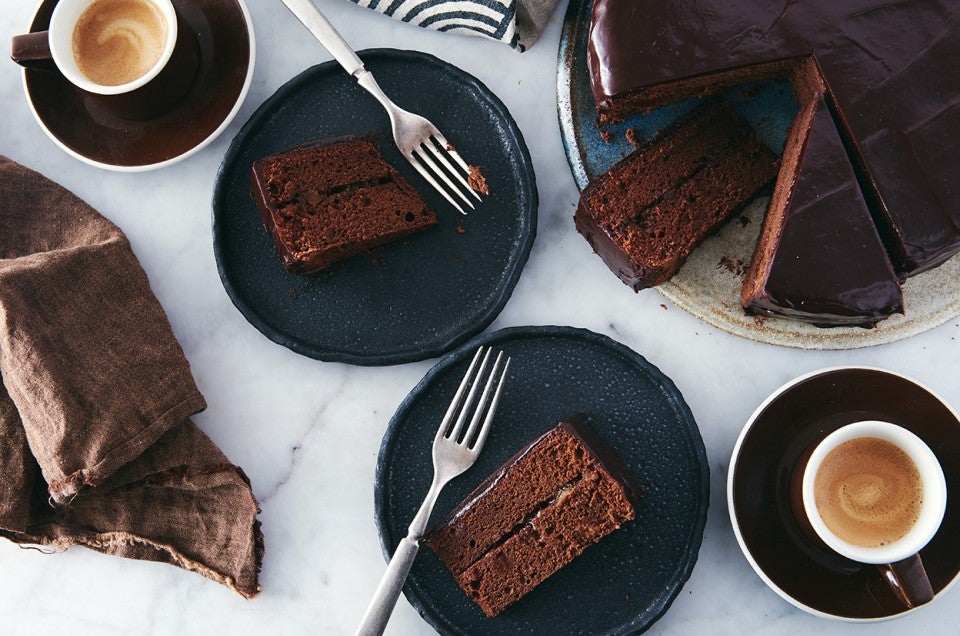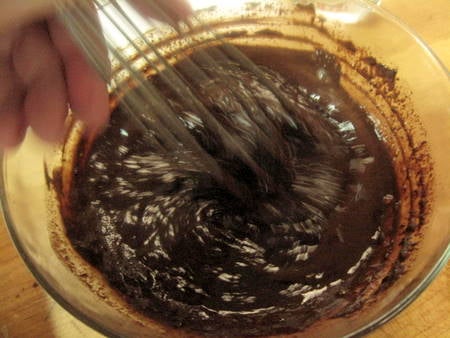


For many of us, holidays and celebrations just aren't complete without chocolate cake. For many years I made a version of the King Arthur Favorite Fudge Cake for most occasions, and we were all very happy.
When researching traditional holiday foods for our holiday traditions series, I came upon this Sacher Torte, and our holiday tables will be forever changed.
According to the Sacher Hotel Web site, the story of the legendary chocolate cake filled with apricot jam began in 1832 in Vienna. Franz Sacher was a 16-year-old apprentice at the court of Prince Metternich when he was asked to create an especially delicious dessert for distinguished guests. The guests loved the cake filled with sweet jam, and it became known as the Sacher-Torte.
The recipe of the Hotel Sacher's version of the cake is a closely-guarded secret. Those privy to it claim that the secret to the Sacher Torte's desirability lies not in the ingredients of the cake itself, but rather those of the chocolate icing.
According to widely available information, the icing consists of three special types of chocolate, which are produced exclusively by different manufacturers for this sole purpose.
Our recipe is based upon one given to me by fellow baker Frank Tegethoff. Frank is a classically trained pastry chef and has worked all over the world. He's a stickler for proper pastry techniques, and poor Frank worked diligently with me on my cake skills and more importantly my pronunciation for this recipe.The conversations would go something like this:
MJ: Sasher torte
Frank: Zachertorte (with great rolling of r's and guttural notes)
MJ: Soccertorte (with nasal accents, à la allergies)
Frank (shaking head): No, no... Zacherrrrtorrrrte!
Round and round we would go as we worked until I *think* we reached a happy medium. At any rate, we produced a spectacular dessert!
Let's make Sacher Torte.
Begin by melting your chocolate over a double boiler or in the microwave. Stir until no lumps remain and the chocolate is just warm to the touch.
In a medium-sized bowl whisk the egg yolks until well blended.
Add the melted chocolate and stir gently.
Add the melted butter and vanilla. Keep blending with a fork or whisk until the mixture is smooth, satiny, and slightly thickened. Set this chocolate mixture aside while you whip the egg whites.
In the bowl of a stand mixer add a pinch of salt to the egg whites and whip until they begin to foam.
With the mixer running on medium speed, slowly add the sugar. Increase the speed to high.
Continue to whip the egg whites until they'll hold a stiff peak. The whites should still be glossy looking, not dry or clumpy.
Wow! If your whites can support a spatula, you're good to go.
Frank showed me the way he learned to judge if the whites were sufficiently whipped. His teacher, Sister Audrey, taught him that if you could hold the bowl of whites over your head and say a full Hail Mary, they were just right. And YES, the bowl really is full of whites. I was short on faith, so snapped the picture quickly, but the whites held just fine.
Take about 1/3 of the whites and stir them into your chocolate mixture. This will lighten the mixture and allow the rest of the whites to fold in easily.
In two stages add the rest of the whites. Fold gently using a wide spatula, turning your bowl a bit after each fold. Stop when you see just small streaks of white left in the batter.
Sift the dry ingredients over the surface of the batter and fold them in gently. The batter will deflate just the tiniest bit. Stop as soon as most of the flour is incorporated into the batter; it's best not to over-mix and risk deflating the batter.
If your pan well and truly measures 2” deep, you can fill it nearly to the top with batter. If you have any doubts, use two pans.
See what I mean? If this pan were any less than 2” high, I'd be cleaning the oven!
Bake until the cake is light, puffy, and a cake tester tests clean when inserted into the center of the cake. There'll be a thin crust on top of the cake. Frank calls this a sugar crust, and it can be sliced off or brushed off by hand to give a smooth top to the cake once it cools.
Immediately after baking run a nylon spreader or other thin-bladed knife around the inside edge of the cake pan to loosen the cake. Turn the cake out onto a wire rack. Peel off the parchment paper and allow the cake to cool completely.
While the cake is cooling you can prepare the apricot filling. Apricot is very traditional to this cake. I'm not the biggest fan of apricot fillings, but I find in this cake it adds a nice, mellow sweetness without heavy apricot flavor. Do give it a try, or use a mild jam of your choice.
Warm the jam and allow it to filter through a sieve to remove any large pieces of fruit. Set aside to cool.
If you've baked your cake in one pan, you'll need to split it to make it a torte. Use a long, sharp serrated knife to split the cake into two even layers, then fill with the cooled apricot jam.
If you baked the cake in two layers, there's no need to split the cake further, just spread the cooled apricot filling between the layers.
Place the filled cake on a wire rack over a parchment-lined baking sheet with a rim. This will raise the cake and provide a tray to catch the hot chocolate glaze as you pour it over the cake.
To make the hot water glaze it's essential to have your ingredients and tools ready to go, as this technique relies on working quickly.
Melt the chocolate in a microwave-safe bowl, or in a double boiler. While the chocolate is melting, heat the water to boiling.
Quickly pour all of the water into the chocolate and whisk quickly to combine.
At first the water and chocolate won't seem to combine, but suddenly they'll blend together into a smooth liquid glaze. It's key to NOT stop whisking until this happens, though, or you may end up with a lump of chocolate in a pool of hot water.
Immediately pour the hot glaze over the cake, spreading it quickly over the top and sides of the cake.
Push the glaze over the edge of the cake to coat the sides. You can scoop up the glaze from the baking sheet to cover up bare spots, if needed.
I tried this technique with our chocolate Belcolade discs, and with our chocolate chips. The glaze made with the chocolate chips was a bit thicker to work with and required more spreading, but the flavor was just fine.
As the glaze begins to set you can use a long straight edge to smooth out the top of the cake. Allow the glaze to set up before you move the cake to its serving plate.
For a final elegant touch, you can use leftover glaze (or another batch) to pipe decorations on the cake. Traditionally, just the word Sacher is piped onto the cake, but you can definitely add your own personal touch.
This cake is best served the day that it's made, or the day after. It has a light, airy texture that becomes denser and sweeter in the center as the apricot jam is absorbed into the sponge. The rich chocolate coat adds gloss and shine, as well as melting lusciously on the tongue. A piece of Sacher Torte will definitely finish any holiday occasion with style.
Please bake, rate, and review our recipe for Sacher Torte.

























